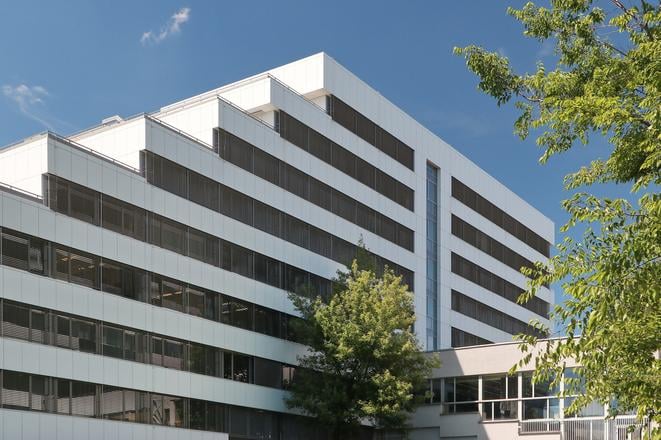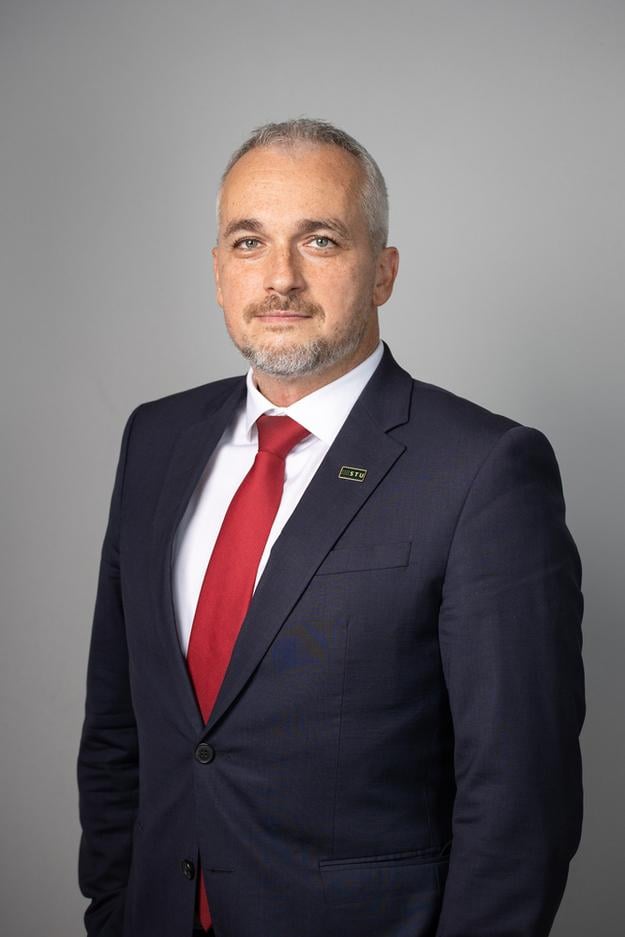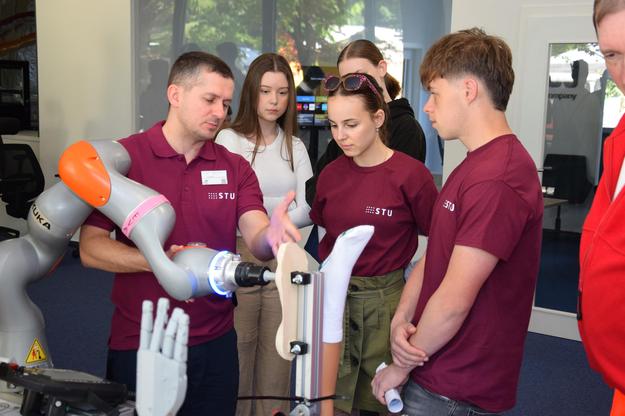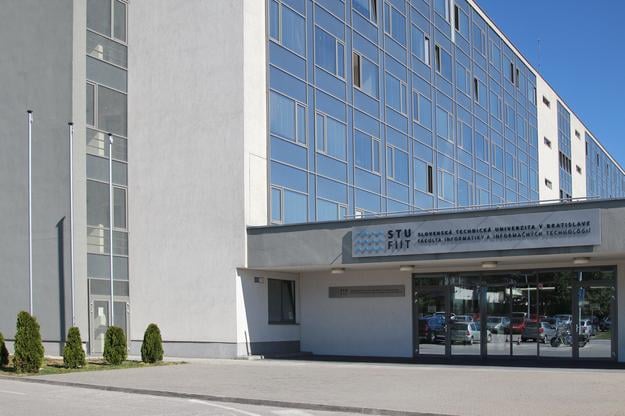Miroslav Trnka, one of the founders of the global cybersecurity company Eset; Štefan Klein, designer of two models of flying car; and Alena Vanková, operations manager at the nuclear power plant in Mochovce. These are just a few of the successful graduates from the Slovak University of Technology in Bratislava (STU) who have pursued distinguished and well-rewarded careers.
“Our graduates have absolutely no problems finding a job,” said Maximilián Strémy, Vice-Rector for Strategic Projects, Development, Innovation and Praxis at STU. “Up to now, STU graduates have had the highest valuation on the Slovak labour market, on average.”
What is STU’s position within the field of technical education?
STU has the longest history within technical education in Slovakia, linking back to the tradition of the Mining Academy in Banská Štiavnica. It has educated almost 200,000 graduates so far and has helped change the nature of this country from agrarian to industrial. It is the main supplier of graduates to all the renowned companies that exist in Slovakia and that make up the national economy. Companies have a direct opportunity to suggest, influence and modify study programmes, as we are trying to keep up with the requirements of industry. As a consequence, our students have no problem getting employment after graduation; quite the contrary. Employers have a problem recruiting fresh graduates as they start working at companies already in the second or third years of their studies. Another advantage is the high income graduates immediately receive after completing their studies. Actually, they are the highest on average. This is, however, not only Slovakia’s speciality. The same situation also pertains in other countries, like the Czech Republic. Technical majors are really worth studying.
Why then is interest in studying technical subjects declining?
STU was registering a drop in interest, and in its number of students, too. In the last three years, we have managed to stabilize the number of students at 11 thousand. About 10 years ago we had 6,000-7,000 more students – more than 17,000. This drop has a negative impact on industry. Companies lack a qualified labour force, with negative consequences forecast for the economy and competitiveness in general.
Part of the decline in the number of students is due to demographics, with the number of young people shrinking. We are making up for this with foreign students. Today they comprise about 20 percent of all our students. Nevertheless, such internationalisation is very welcome and proof that mobility is working in both directions and on both sides, for students as well as teachers.
The reasons behind the lower interest are wide-ranging, but what dominates is the perspective linked with quality of life and expectations. So my job is mainly to show young people the life prospects that make studying and working in Slovakia sensible – that will give them the space to realise their ideas and dreams.
Which action by the state could help?
The promotion of technical education as such. We might also think about how to prioritise even more those technical areas that are interesting for Slovakia, which is an industrial country. One of the most discussed strategies could be to make a forecast for the next 10 years and identify how many, for example, mechanical or energy engineers, economists, doctors, lawyers or philosophers Slovakia will need. Then set the funding for universities accordingly and prioritise those professions necessary for the Slovak economy.
An apolitical dialogue would help, too. Strategies and financial schemes in education, science and innovation have been changing with each minister. And there are two to three ministers during each government’s term. It is very difficult to operate in such a constantly changing environment.
Can the reintroduction of compulsory maths leaving exams help to increase the number of students?
We would certainly be pleased if Slovakia agreed to this. The leaving exam in maths is an investment in the future by students. For example, in Germany maths also serves as a subject in the admissions to the medical faculty. This documents its importance even in fields where we would not expect it. Basically, what matters is quality education, whether or not a leaving exam in maths is compulsory for all students.
What about funding?
Last year Education Minister Tomáš Drucker obtained an additional €1 billion for the education sector. Of this sum, €600 million is planned for kindergartens and the rest for secondary schools and universities. I believe that there is space to set up better financing and support of technical studies. As Dan Shechtman, a Nobel prize winner from Israel – the country with the highest number of startups per capita in the world – said during his lecture at STU in December 2024, it is important to inspire and educate children already from kindergarten. He received the biggest applause I have ever heard in our hall.
Is STU somehow active in this direction?
Yes. STU has launched the first university kindergarten in Slovakia. It is designed primarily for our students and staff. Now there are 20-25 children. Motivated by Dan Shechtman as well as the experience within the European alliance of universities in which we operate. The first programmes for children towards technical education have already taken place there. For example, associate professor Lucia Birosová explained chemistry topics to them at a level suitable for their age. This is where it’s necessary to start.
What specifically do you offer to young people who are seeking a place to study?
There is a tremendous amount of activities that we do. A matter of course are internships, either in Slovakia or abroad, specialised workshops, visits by companies, cooperation in scientific works at all three levels: bachelor, diploma and dissertation, all done in close cooperation with the industry sector and in relation to the latest needs, scientific research and innovations.
We actively support our students in developing their ideas. We have a dedicated place for this at STU: the University Technological Incubator. Here they can meet with mentors, people with real life experience, who themselves have launched successful startups. They help to set up a business plan and business strategy. Those who are most successful can obtain financing for their startups.
Have any of your students achieved any interesting results?
Recently two projects from our incubator succeeded in the Student Entrepreneurship Award. Roman Osadský, with his Rewardly project from STU’s Faculty of Informatics and Information Technology STU, was the absolute winner. It deals with the possibilities of digitalisation and simplification of loyalty programmes. The BMW Slovak Republic Award for Innovation was awarded to Martin Koleják, from the same faculty. His MeltFlex project pushes the possibilities of 3D printing into new and previously unsuspected dimensions.
Does STU cooperate with foreign universities?
In 2023, STU became a fully-fledged member of the European Universities Linking Society and Technology (EULiST). Thanks to this, every student who attends STU will soon be able to spend one year at some of the member universities during their studies, either during the first, second and third degree - up to three years in total during the entire study. These include prominent universities, like Leibniz University Hannover in Germany, Institut Mines-Télécom in France, TU Wien, or the Brno University of Technology. In total, they can spend three years abroad if studying the first, second and third degree. Very simply put, students do not have to go abroad to study: they can study abroad at STU.
Milestones of the Slovak University of Technology in Bratislava (STU)
- Higher technical education in Slovakia goes back to 1762, when Maria Theresa issued a decree concerning the Academy of Mining and Forestry in Banská Štiavnica. It was the first educational institution on the territory of present-day Slovakia, providing technical education at the university level.
- The first polytechnic university in Slovakia, the Technical University of M.R. Štefánik, was founded in Košice in 1937.
- In 1939 it was renamed the Slovak Technical University (SVŠT – Slovenská Vysoká Škola Technická) and moved to its present location: Bratislava. It featured six branches.
- The university’s branches were renamed faculties and there have been five of them since the 1950/1951 academic year: Construction Engineering, Mechanical and Electrical Engineering, Chemical Engineering, Specialised Sciences, and Architecture and Construction Engineering
- The Faculty of Mining Engineering was separated from the Slovak Technical University in the 1952/1953 academic year and incorporated as part of the new Technical University in Košice.
- On January 1, 1986, the Faculty of Machine Technology was established in the town of Trnava, 50 km from Bratislava, and in 1991 this faculty was renamed the Faculty of Materials Science and Technology.
- SVŠT was renamed the Slovak University of Technology in Bratislava (Slovenská Technická Univerzita v Bratislave) in 1991.
The Slovak University of Technology in Bratislava consists of seven faculties and one institute:
Faculty of Civil Engineering (SvF)
Faculty of Mechanical Engineering (SjF)
Faculty of Electrical Engineering and Information Technology (FEI)
Faculty of Chemical and Food Technology (FCHPT)
Faculty of Architecture and Design (FAD)
Faculty of Materials Science and Technology in Trnava (MTF)

 Slovak University of Technology in Bratislava (source: Mgr.art. Matej Kovac)
Slovak University of Technology in Bratislava (source: Mgr.art. Matej Kovac)
 prof. Ing. Maximilián Strémy, PhD.
prorektor pre strategické projekty, rozvoj, inovácie a prax (source: STU BA)
prof. Ing. Maximilián Strémy, PhD.
prorektor pre strategické projekty, rozvoj, inovácie a prax (source: STU BA)
 STU (source: STU BA)
STU (source: STU BA)
 Slovak University of Technology in Bratislava (source: STU BA)
Slovak University of Technology in Bratislava (source: STU BA)
 Slovak University of Technology in Bratislava (source: Tibor Rózsár)
Slovak University of Technology in Bratislava (source: Tibor Rózsár)
 Slovak University of Technology in Bratislava (STU) (source: Tibor Rózsár)
Slovak University of Technology in Bratislava (STU) (source: Tibor Rózsár)